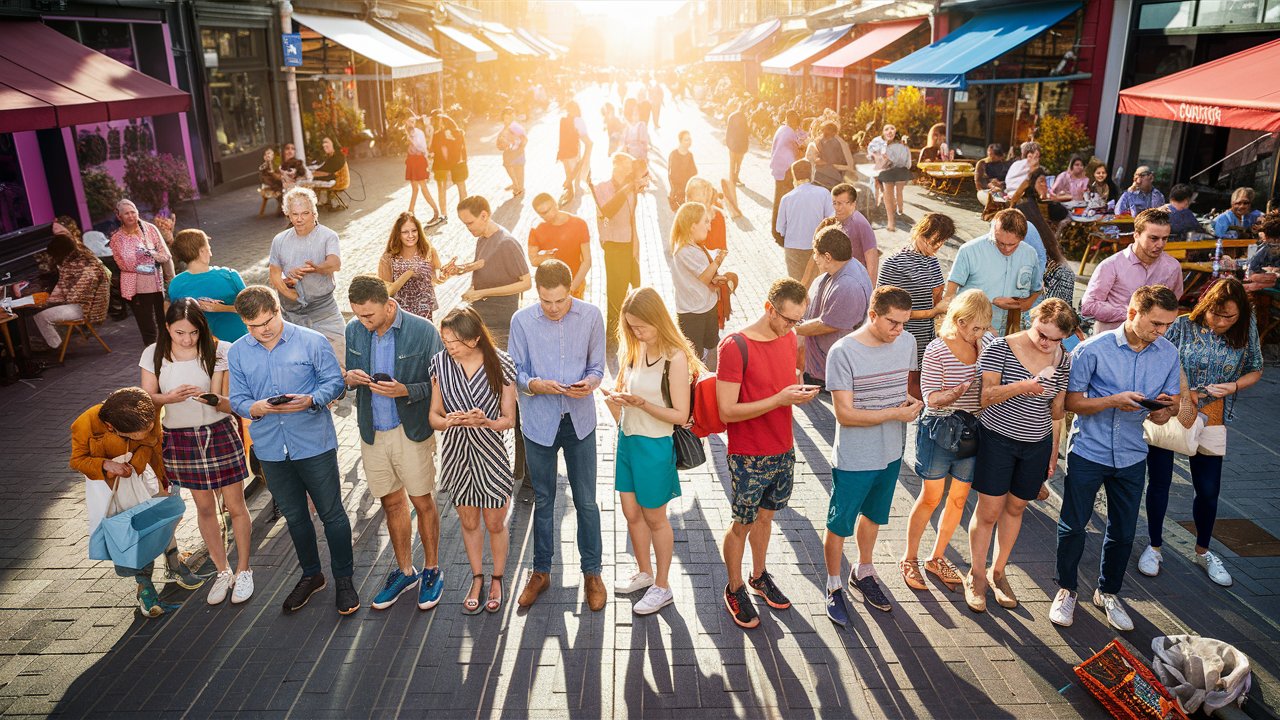Aug 21 · 5 min read
The Impact of Mobile Shopping on India’s E-Commerce Growth

The Impact of Mobile Shopping on India’s E-Commerce Growth
Introduction: The Mobile Revolution is Here!
Remember the days when shopping meant walking through crowded markets, visiting multiple stores, and haggling for the best price? Fast forward to today, and all of that can now be done from the comfort of your couch—or really, from anywhere. This shift is all thanks to mobile shopping, a phenomenon that has dramatically reshaped India’s e-commerce landscape. Whether you're relaxing at home, commuting on a bus, or taking a break at work, you can now shop for virtually anything you need with just a few taps on your smartphone. It’s convenience at its finest.
But this isn’t just about ease of use; it’s about how mobile shopping has become the backbone of e-commerce growth in India. From making shopping more accessible to a broader audience to creating new business opportunities, the impact of mobile shopping is far-reaching. In this comprehensive blog, we’re going to explore how mobile shopping has revolutionized e-commerce in India. We’ll look at how apps have turned smartphones into pocket-sized shopping malls, why young consumers are driving this trend, and what the future holds for mobile commerce. And stick around until the end, where we’ll share tips on how to leverage this trend to get the best deals!
The Smartphone Boom: India’s New Shopping Hub
To understand the impact of mobile shopping, we first need to look at the driving force behind it: smartphones. A little over a decade ago, smartphones were a luxury item in India, affordable only to a select few. Fast forward to today, and they’ve become an essential part of daily life for millions of Indians. The rise in smartphone usage is nothing short of a revolution, with India now ranking as one of the largest smartphone markets in the world.
What’s behind this surge? For one, the availability of affordable smartphones has made them accessible to a much wider audience. Companies like Xiaomi, Samsung, and Realme have launched budget-friendly models that offer impressive features at a fraction of the cost of premium brands. Additionally, the widespread availability of high-speed mobile internet, thanks to telecom giants like Jio, has made it easier for people across India to stay connected and make the most of their smartphones.
The result? A massive shift in how Indians shop. With powerful devices in their hands and easy access to the internet, more and more people are turning to their smartphones for online shopping. This trend has given rise to a whole new sector within e-commerce: mobile commerce, or m-commerce. Unlike traditional online shopping, which typically takes place on desktop computers, m-commerce happens exclusively on mobile devices. And it’s growing at an unprecedented rate.
Mobile Shopping Apps: The New BFFs of Shoppers
Now that we’ve established the importance of smartphones in this equation, let’s dive into the heart of mobile shopping: the apps. These tiny icons on your phone’s screen have become the gateways to a world of endless products and services. Whether it’s Amazon, Flipkart, Myntra, or any other shopping app, these platforms have redefined how we think about shopping.

So, what makes these apps so special? For starters, they’re incredibly user-friendly. Mobile shopping apps are designed to make the shopping experience as seamless and enjoyable as possible. They feature intuitive interfaces, personalized recommendations, secure payment options, and easy navigation. This means that even someone who’s not particularly tech-savvy can browse, select, and purchase items with ease.
One of the key features that set mobile shopping apps apart is personalization. These apps use advanced algorithms powered by artificial intelligence (AI) and machine learning to analyze your browsing and purchasing behavior. They then use this data to suggest products that are tailored to your preferences. For example, if you frequently browse for sneakers, the app will start showing you deals on sneakers, new arrivals, and even related items like athletic wear or socks. This level of personalization creates a shopping experience that feels highly customized and engaging.
Moreover, these apps have mastered the art of convenience. Gone are the days when you had to visit multiple websites to compare prices or check reviews. Now, everything you need is integrated into a single platform. Want to know if a product is worth buying? Check the reviews right there in the app. Curious about pricing? Use the built-in price comparison tool. Need to make a payment? Choose from a range of secure options, including mobile wallets, credit/debit cards, and even cash on delivery.
The Psychology Behind Mobile Shopping: Why It’s So Addictive
Let’s pause for a moment and think about why mobile shopping is so addictive. What is it about these apps that keeps us coming back for more? The answer lies in the psychology of mobile shopping.
Firstly, mobile shopping taps into our desire for instant gratification. The ability to make a purchase with just a few taps satisfies our need for quick and easy rewards. This is especially true for younger consumers, who are used to getting what they want, when they want it. Whether it’s ordering food, booking a cab, or shopping for clothes, the entire process is designed to be fast and frictionless.
Secondly, mobile shopping apps create a sense of urgency that drives impulse buying. Features like flash sales, limited-time offers, and countdown timers play on our fear of missing out (FOMO). When you see that there are only a few items left in stock, or that a discount is about to expire, you’re more likely to make a purchase on the spot, even if you hadn’t planned to buy anything.
Another psychological factor is the social aspect of mobile shopping. Many shopping apps integrate social media features, allowing users to share their purchases, follow influencers, and see what their friends are buying. This creates a community-like environment where shopping becomes a social activity, rather than a solitary one. The ability to see what others are buying and recommending can influence your own purchasing decisions, making you more likely to buy products that are trending or endorsed by your peers.
Lastly, mobile shopping apps often reward users with points, badges, and other forms of recognition for making purchases or engaging with the app. These rewards trigger the release of dopamine, a neurotransmitter associated with pleasure and reward, making the shopping experience feel even more satisfying. Over time, this can lead to habitual behavior, where users keep returning to the app in search of more rewards and positive reinforcement.
Why Young Consumers are Leading the Mobile Shopping Charge
While mobile shopping is popular across all age groups, it’s particularly dominant among younger consumers—specifically, Millennials and Gen Z. These are the digital natives who have grown up with technology and are most comfortable using it in their daily lives. For them, shopping with their phones is as natural as chatting with friends or posting on social media.
One of the main reasons young consumers are leading the mobile shopping charge is convenience. Young people are constantly on the move, juggling work, studies, social activities, and more. Mobile shopping fits perfectly into their fast-paced lifestyles, allowing them to shop anytime, anywhere. Whether they’re commuting, taking a break at work, or hanging out with friends, they can quickly browse for products, make purchases, and even track their orders—all from their mobile devices.
Another factor driving this trend is the desire for personalized experiences. Young consumers expect brands to understand their preferences and offer products and services that align with their tastes. Mobile shopping apps cater to this need by providing personalized recommendations, targeted ads, and curated collections based on user behavior. T

Conclusion: How to Make the Most of Mobile Shopping
As we’ve seen, mobile shopping has had a profound impact on e-commerce in India. From the convenience of shopping on the go to the personalization of app experiences, mobile commerce has transformed the way we shop. With advancements in technology and the growing influence of younger consumers, the future of mobile shopping looks bright.
If you’re looking to make the most of mobile shopping, here are a few tips to keep in mind:
- Download the Right Apps: Choose apps that offer a great user experience, personalized recommendations, and secure payment options.
- Look for Deals and Discounts: Keep an eye out for special offers, flash sales, and exclusive app-only deals to save money on your purchases.
- Use Mobile Wallets: Take advantage of mobile wallets for fast, secure, and convenient payments.
- Stay Updated: Follow your favorite brands and shopping apps on social media to stay informed about new products, promotions, and events.
And if you’re ready to start shopping, don’t forget to check out Deals2buy.in for the best deals on a wide range of products. From fashion and electronics to home essentials and more, we’ve got you covered with unbeatable discounts. Happy shopping!

